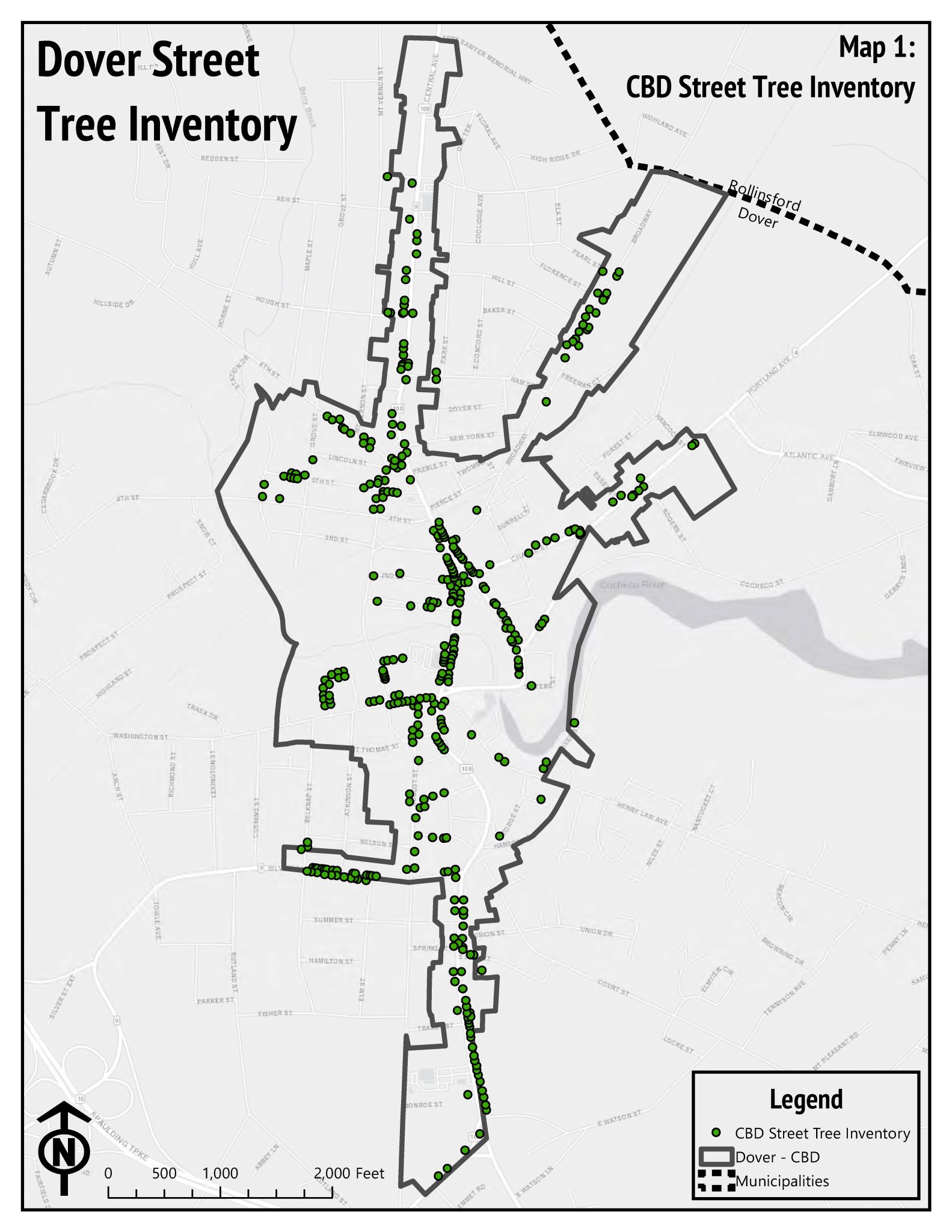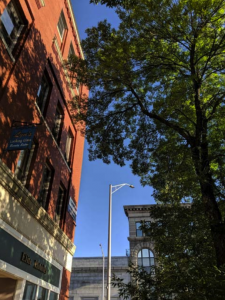By: Kyle Pimental, Strafford Regional Planning Commission
Thanks to a collaborative effort, the City of Dover has a new Urban Street Tree Plan for the Central Business District. In 2019, the City of Dover, in partnership with the Strafford Regional Planning Commission (SRPC), received funding through the New Hampshire Department of Environmental Services (NHDES) Coastal Program Resilience Planning Grant Program to implement several actions identified in the City’s 2018 Climate Adaptation Master Plan, including addressing extreme heat and increased stormwater runoff from increases in precipitation. The goal of the project was to strengthen Dover’s resilience to climate change by improving the City’s urban landscape through various mechanisms and providing education on innovative approaches to stormwater design.

SPRC collaborated with former SPRC employee, Liz Durfee, Owner and Principal of EF Design & Planning, LLC, to develop the comprehensive inventory and analysis of existing street trees within the Central Business District. The plan includes:
- Guiding principles and objectives for the plan and a discussion of the role and value of street trees.
- Information about the CBD street tree inventory that was conducted in the summer of 2020 and an analysis of inventory results.
- A summary of a City-wide GIS-based canopy cover and socio-economic data assessment and accompanying maps.
- A discussion of CBD street tree management, including species selection and street tree design considerations, installation, and maintenance.
- An implementation schedule to increase resiliency based on street tree inventory findings.
“This project is meaningful to me in a number of ways,” said Durfee. “My involvement in an urban tree canopy program while working as an Americorps VISTA with the Urban Ecology Institute in Boston back in 2007 played a defining role in the trajectory of my education and career. It honed my awareness of the role green infrastructure plays in creating healthy and comfortable places to live and helped me to connect my passion for the environment with my interest in improving lives through the built environment.”
 Regarding the Dover project, Ms. Durfee stated, “I really appreciate the emphasis on climate resiliency that this project took on. It presented opportunities to explore ways we can prepare the community’s residents, landscape, and street trees for a changing climate. The inventory ended up being a great way for volunteers to get involved in a community project during the pandemic. We provided a detailed guide on the data collection process and individuals were able to go out on their own and complete the tree survey with a mobile app or paper questionnaire.”
Regarding the Dover project, Ms. Durfee stated, “I really appreciate the emphasis on climate resiliency that this project took on. It presented opportunities to explore ways we can prepare the community’s residents, landscape, and street trees for a changing climate. The inventory ended up being a great way for volunteers to get involved in a community project during the pandemic. We provided a detailed guide on the data collection process and individuals were able to go out on their own and complete the tree survey with a mobile app or paper questionnaire.”
Kyle Pimental, Principal Regional Planner at SRPC, stressed the importance of projects like this one by saying, “urban street trees provide a myriad of benefits to the environment and the community, including mitigating greenhouse gases, storing and sequestering carbon dioxide, improving air quality, and reducing urban heat island effect. This plan provides a framework that outlines the long-term health and vitality of the City’s street trees to ensure they reach maturity and provide the maximum value to the community.”
When asked about how this plan could be used at the local level, City Planner Steve Bird said, “the recently completed urban street plan will be a very useful tool for the City to use as it moves forward with the planting of new street trees in the downtown area. The plan contains important recommendations on the appropriate types of trees that will thrive and help to create crucial shade in an area with significant impervious pavement and sidewalks, while making the downtown more attractive and pedestrian friendly.”
For Dover to sustain this effort beyond the life of the grant, the City has created a Forest Management subcommittee, which is embarking on an effort to develop forest management plans for City-owned parcels. More specifically, the subcommittee will be making recommendations on how managed timber harvests can produce potential revenue sources that could be incorporated into the City’s operating budget to pay for future street tree plantings.
